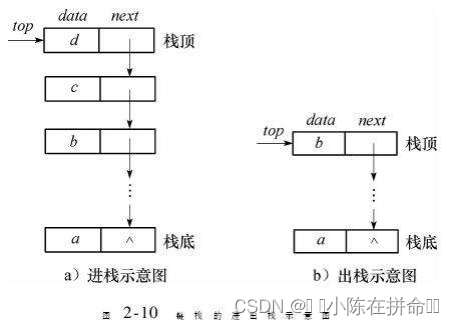创作不易,友友们给个三连吧!!
一、栈的概念及结构
栈:一种特殊的线性表,其只允许在固定的一端进行插入和删除元素操作。进行数据插入和删除操作的一端称为栈顶,另一端称为栈底。栈中的数据元素遵守后进先出LIFO(Last In First Out)的原则。
压栈:栈的插入操作叫做进栈/压栈/入栈,入数据在栈顶。
出栈:栈的删除操作叫做出栈。出数据也在栈顶。


二、顺序栈的实现
数组实现栈:

首元素当栈低,栈顶是数组的尾元素,压栈就是尾插,出栈就是尾删
链表实现栈:

链表的最后一个结点当栈底,栈顶是链表的头结点,压栈就是头插,出栈就是头删
栈的实现一般可以使用数组或者链表实现,相对而言数组的结构实现更优一些。因为数组在尾上插入数据的代价比较小。
由于这些操作和顺序表的实现基本上是一样的,所以以下的介绍不做详细讲解。
建议大家看看博主关于顺序表的实现,再来看下面代码就易如反掌了!!
2.1 栈相关结构体
下面是定长的静态栈的结构,实际中一般不实用,因为设置得太小容易不够,设置得太大容易浪费
typedef int STDataType;
#define N 10
typedef struct Stack
{
STDataType _a[N];
int _top; // 栈顶
}Stack;以我们主要实现下面的支持动态增长的栈
typedef int STDataType;
//支持动态增长的栈
typedef struct Stack
{
STDataType* a;
int top;//栈顶
int capacity;//栈容量
}Stack;2.2 初始化栈
void StackInit(Stack* ps)
{
ps->a = NULL;
ps->top = ps->capacity = 0;
}ps->top并不指向栈顶元素,而是指向栈顶元素的下一个位置,如果想要指向栈顶元素,则需要给top赋值-1.但是给top赋值0也有好处,就是top的值就相当于是顺序表中的size,即表示栈中的有效数据个数
2.3 压栈
void StackPush(Stack* ps, STDataType x)
{
assert(ps);
//判断是否需要扩容
if (ps->top == ps->capacity)
{
int newcapacity = ps->capacity == 0 ? 4 : 2 * ps->capacity;
STDataType* temp = (STDataType*)realloc(ps->a,sizeof(STDataType) * newcapacity);
if (temp == NULL)
{
perror("realloc fail");
exit(1);
}
ps->a = temp;
ps->capacity = newcapacity;
}
//压栈
ps->a[ps->top++] = x;
}2.4 出栈
void StackPop(Stack* ps)
{
assert(ps);
//如果栈为空,则没有删除的必要
assert(!StackEmpty(ps));
ps->top--;
}2.5 获取栈顶元素
STDataType StackTop(Stack* ps)
{
assert(ps);
//如果栈为空,不可能有栈顶元素
assert(!StackEmpty(ps));
return ps->a[ps->top - 1];
}要注意:因为我们初始化的top是0,所以top指向的是栈顶元素的下一个位置!
2.6 获取栈中有效元素个数
int StackSize(Stack* ps)
{
assert(ps);
return ps->top;
}因为top初始赋值为0, 所以top其实就相当于栈中的有效数据个数,专门封装一个函数只是想提高可读性!
2.7 检测栈是否为空
bool StackEmpty(Stack* ps)
{
assert(ps);
return ps->top == 0;
}在顺序表中,是否为空只需要看有效容量个数是不是0即可,但是在顺序栈中有效数据个数size被替换成了 top,虽然我们知道top和size的意思差不多,但是如果在代码里直接用的话可读性就没有size这么好,所以单独设置一个检测栈是否为空的函数。
2.8 销毁栈
void StackDestory(Stack* ps)
{
free(ps->a);
ps->a = NULL;
ps->top = ps->capacity = 0;
}2.9 打印栈
栈相比较于顺序表,并不具备随机访问的特点,因为栈是后进先出的,也就是说如果我们要遍历栈去访问栈中的每个元素,那么就需要一边获取栈顶元素一边出栈,这其实就会破坏原先栈的结构了,一般只能使用一次,不具备复用性,因此没必要单独封装一个函数。如果实在想打印栈,那么就在main函数中这样测试一下
#include"Stack.h"
int main()
{
Stack sk;
StackInit(&sk);
StackPush(&sk, 1);
StackPush(&sk, 2);
StackPush(&sk, 3);
StackPush(&sk, 4);
while (!StackEmpty(&sk))
{
printf("%d ", StackTop(&sk));//一边打印栈顶元素
StackPop(&sk);//一边出栈
}
}三、顺序栈实现的所有代码
3.1 Stack.h
#pragma once
#include<stdio.h>
#include<stdbool.h>
#include<stdlib.h>
#include<assert.h>
typedef int STDataType;
//支持动态增长的栈
typedef struct Stack
{
STDataType* a;
int top;//栈顶
int capacity;//栈容量
}Stack;
void StackInit(Stack* ps);//初始化栈
void StackPush(Stack* ps, STDataType x);//入栈
void StackPop(Stack* ps);//出栈
STDataType StackTop(Stack* ps);//获取栈顶元素
int StackSize(Stack* ps);//获取栈中有效元素个数
bool StackEmpty(Stack* ps);//检测栈是否为空,为空返回true
void StackDestory(Stack* ps);//销毁栈3.2 Stack.c
#include"Stack.h"
void StackInit(Stack* ps)
{
ps->a = NULL;
ps->top = ps->capacity = 0;
}
void StackPush(Stack* ps, STDataType x)
{
assert(ps);
//判断是否需要扩容
if (ps->top == ps->capacity)
{
int newcapacity = ps->capacity == 0 ? 4 : 2 * ps->capacity;
STDataType* temp = (STDataType*)realloc(ps->a,sizeof(STDataType) * newcapacity);
if (temp == NULL)
{
perror("realloc fail");
exit(1);
}
ps->a = temp;
ps->capacity = newcapacity;
}
//压栈
ps->a[ps->top++] = x;
}
void StackPop(Stack* ps)
{
assert(ps);
//如果栈为空,则没有删除的必要
assert(!StackEmpty(ps));
ps->top--;
}
STDataType StackTop(Stack* ps)
{
assert(ps);
//如果栈为空,不可能有栈顶元素
assert(!StackEmpty(ps));
return ps->a[ps->top - 1];
}
int StackSize(Stack* ps)
{
assert(ps);
return ps->top;
}
bool StackEmpty(Stack* ps)
{
assert(ps);
return ps->top == 0;
}
void StackDestory(Stack* ps)
{
free(ps->a);
ps->a = NULL;
ps->top = ps->capacity = 0;
}
3.3 test.c(测试)
#include"Stack.h"
int main()
{
Stack sk;
StackInit(&sk);
StackPush(&sk, 1);
StackPush(&sk, 2);
StackPush(&sk, 3);
StackPush(&sk, 4);
while (!StackEmpty(&sk))
{
printf("%d ", StackTop(&sk));//一边打印栈顶元素
StackPop(&sk);//一边出栈
}
}四、栈的相关oj题
4.1 选择题
1、一个栈的初始状态为空。现将元素1、2、3、4、5、A、B、C、D、E依次入栈,然后再依次出栈,则元素出
栈的顺序是(B)。
A 12345ABCDE
B EDCBA54321
C ABCDE12345
D 54321EDCBA
解析:后进先出的特点,进栈过程中如果没有出栈,入栈和出栈的顺序是相反的。
2.若进栈序列为 1,2,3,4 ,进栈过程中可以出栈,则下列不可能的一个出栈序列是(C)
A 1,4,3,2
B 2,3,4,1
C 3,1,4,2
D 3,4,2,1
解析:虽然是后进先出,但是入栈和出栈顺序相反是相对的,重点就是要判断进栈过程中是否有出栈,题目有明确提出这一点,所以这题最好同过画图去排除可能性,比如C,3出栈说明1和2都在栈内,下一个要出栈的话只能是2不能是1,1不可能在2的前面出栈。
4.2 有效的括号(OJ题)

条件的意思是:括号可以相互包含,放不能参差摆放
思路:利用栈结构后进先出的特点,让左括号入栈,右括号出栈匹配,当左右括号相等的前提下,如果最后栈为空,则符合题目要求,左括号大于右括号和右括号大于左括号要分开讨论。
typedef char STDataType;
//支持动态增长的栈
typedef struct Stack
{
STDataType* a;
int top;//栈顶
int capacity;//栈容量
}Stack;
void StackInit(Stack* ps);//初始化栈
void StackPush(Stack* ps, STDataType x);//入栈
void StackPop(Stack* ps);//出栈
STDataType StackTop(Stack* ps);//获取栈顶元素
int StackSize(Stack* ps);//获取栈中有效元素个数
bool StackEmpty(Stack* ps);//检测栈是否为空,为空返回true
void StackDestory(Stack* ps);//销毁栈
void StackInit(Stack* ps)
{
ps->a = NULL;
ps->top = ps->capacity = 0;
}
void StackPush(Stack* ps, STDataType x)
{
assert(ps);
//判断是否需要扩容
if (ps->top == ps->capacity)
{
int newcapacity = ps->capacity == 0 ? 4 : 2 * ps->capacity;
STDataType* temp = (STDataType*)realloc(ps->a,sizeof(STDataType) * newcapacity);
if (temp == NULL)
{
perror("realloc fail");
exit(1);
}
ps->a = temp;
ps->capacity = newcapacity;
}
//压栈
ps->a[ps->top++] = x;
}
void StackPop(Stack* ps)
{
assert(ps);
//如果栈为空,则没有删除的必要
assert(!StackEmpty(ps));
ps->top--;
}
STDataType StackTop(Stack* ps)
{
assert(ps);
//如果栈为空,不可能有栈顶元素
assert(!StackEmpty(ps));
return ps->a[ps->top - 1];
}
int StackSize(Stack* ps)
{
assert(ps);
return ps->top;
}
bool StackEmpty(Stack* ps)
{
assert(ps);
return ps->top == 0;
}
void StackDestory(Stack* ps)
{
free(ps->a);
ps->a = NULL;
ps->top = ps->capacity = 0;
}
bool isValid(char* s)
{
Stack st;
StackInit(&st);
while(*s)
{
if(*s=='('||*s=='{'||*s=='[')
StackPush(&st,*s);
else
{
//如果右比左多,栈为空
if(StackEmpty(&st))
{
StackDestory(&st);
return false;
}
char top=StackTop(&st);
StackPop(&st);
//不匹配
if((*s==')'&&top!='(')||(*s=='}'&&top!='{')||(*s==']'&&top!='['))
{
StackDestory(&st);
return false;
}
}
++s;
}
//如果左括号比右括号多,栈也有元素
bool ret=StackEmpty(&st);
StackDestory(&st);
return ret;
}要注意中间的条件判断!!
























 被折叠的 条评论
为什么被折叠?
被折叠的 条评论
为什么被折叠?








